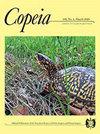墨西哥中部一小属活生昆虫的系统与分类(鲤齿目:好足科)
IF 2.6
Q2 Agricultural and Biological Sciences
引用次数: 0
摘要
Chapalichthys属(cyprinodontiforma: Goodeidae)由三个分布在墨西哥中部梅萨的异域物种组成。Chapalichthys encaustus主要分布在Río Lerma-Santiago盆地,而C. peraticus和C. pardalis在邻近的Río Balsas盆地均有有限分布。属的分类学问题主要围绕着佩尔蒂乌斯的有效性展开。从未对包括所有三个种在内的沙帕利鱼属进行过正式的系统和分类评估。因此,本研究的目的有两个:1)利用1047 bp的mtDNA (ND2)序列数据来评估Chapalichthys多居群和所有3种之间的系统发育关系;2)根据系统发育结果,利用分生和色素特征来重新审视peraticus的分类地位。系统发育表明两个支系,每个支系由一个有效的物种组成。其中一个进化支包括伊库斯库斯的多个种群,另一个进化支包括帕达利库斯和佩拉蒂库斯的多个个体。pardalis和C. peraticus具有几乎相同的线粒体ND2序列。形态学上,所有性状的分生计数显示三个物种都有重叠,没有提供物种特异性的诊断信息。Chapalichthys encaustus与C. pardalis和C. peraticus的区别在于它们的侧翼上有垂直的条纹,而其他两个物种的侧翼上有斑点。pardalis和C. peraticus不能根据色素沉着或特征加以区分。本研究结果仅支持Chapalichthys属的两个种:C. encaustus和C. pardalis。本文章由计算机程序翻译,如有差异,请以英文原文为准。
Systematics and Taxonomy of Chapalichthys (Cyprinodontiformes: Goodeidae), a Small Genus of Live-Bearers from Central Mexico
The genus Chapalichthys (Cyprinodontiformes: Goodeidae) consists of three allopatrically distributed species that occur on the Mesa Central, Mexico. Chapalichthys encaustus primarily occurs in the Río Lerma-Santiago basin, whereas both C. peraticus and C. pardalis have restricted distributions in the adjacent Río Balsas basin. Taxonomic issues in the genus center around the validity of C. peraticus. A formal systematic and taxonomic assessment of the genus inclusive of all three species of Chapalichthys has never been conducted. Therefore, the objectives of this study were two-fold: 1) to assess the phylogenetic relationships among multiple populations and all three species of Chapalichthys using 1,047 bp of mtDNA (ND2) sequence data, and 2) in light of the phylogenetic results, to re-examine the taxonomic status of C. peraticus using meristic and pigmentation characters. The phylogeny indicates two clades, each consisting of a valid species. One clade includes multiple populations of C. encaustus, and a second clade consists of multiple individuals of C. pardalis and C. peraticus. Chapalichthys pardalis and C. peraticus possess nearly identical mitochondrial sequences for ND2. Morphologically, meristic counts of all characters examined showed overlap for all three species and provide no species-specific diagnostic information. Chapalichthys encaustus can be differentiated from C. pardalis and C. peraticus based on the presence of vertical bars along the lateral flank versus a spotted pattern in the other two species. Chapalichthys pardalis and C. peraticus cannot be differentiated from one another based on pigmentation or meristics. The results from this study support the recognition of only two species of Chapalichthys: C. encaustus and C. pardalis.
求助全文
通过发布文献求助,成功后即可免费获取论文全文。
去求助
来源期刊

Copeia
生物-动物学
CiteScore
2.10
自引率
0.00%
发文量
0
审稿时长
6-12 weeks
期刊介绍:
Founded in 1913, Copeia is a highly respected international journal dedicated to the publication of high quality, original research papers on the behavior, conservation, ecology, genetics, morphology, evolution, physiology, systematics and taxonomy of extant and extinct fishes, amphibians, and reptiles. Copeia is published electronically and is available through BioOne. Articles are published online first, and print issues appear four times per year. In addition to research articles, Copeia publishes invited review papers, book reviews, and compiles virtual issues on topics of interest drawn from papers previously published in the journal.
 求助内容:
求助内容: 应助结果提醒方式:
应助结果提醒方式:


